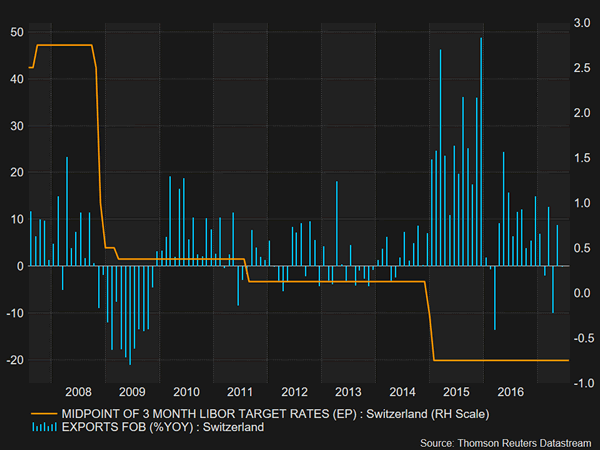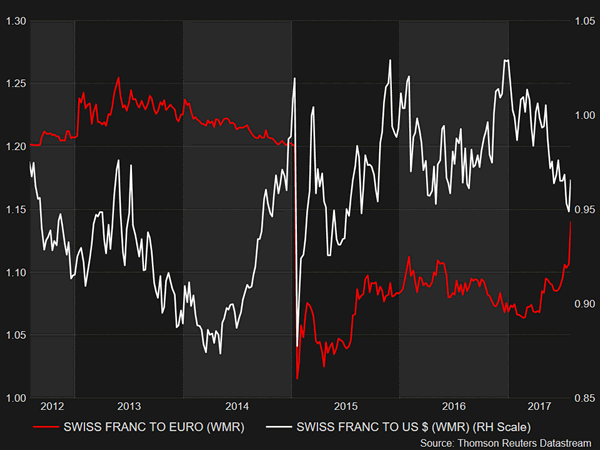After two years of relative stability, the safe-haven swiss franc came into the spotlight again when it came under pressure against the euro last week and broke out of its long-term range. The much-desired weakness will likely be welcome by the Swiss National Bank which longs for a more export-competitive currency. However, the swissie remains "overvalued" as the level of risk aversion in the markets remains quite high despite investors’ rising appetite for riskier assets. The question arising now is for how long the recent retreat will persist.
It was back in 2011 when the Swiss National Bank (SNB) decided to introduce a currency ceiling in a period when an extremely high level of uncertainty in the financial markets increased dramatically the demand for safe-haven assets and therefore strengthened the Swiss franc against other major currencies. The SNB in an attempt to protect domestic exporters from an overvalued currency set a limit of 1.20 francs to the euro, but after four years the SNB scrapped its ceiling, as the bank’s foreign reserves reached almost 80% of Swiss GDP. On January 15, 2015, the swissie jumped by 20%, soaring to an all-time high of 0.8588 francs per euro. The euro managed to climb above parity only after the SNB applied an even looser monetary policy by reducing interest rates (three-month LIBOR) from -0.25% to -0.75%.

However, the swissie started showing signs of weakening recently, after the French elections this spring declared Eurozone supporter, Emanuel Macron, as the next president, removing a layer of uncertainty in the European political environment. Then, a few months later, the currency experienced further correction to the downside, when major central banks and particularly the European Central Bank (ECB) signalled to scale back their ultra-easy monetary policy soon as Eurozone economic indicators were seen to be gathering positive momentum. In addition, traders attributed the recent weakness in the safe-haven franc to decreasing spreads between European government bond yields, reflecting reduced risks for the Eurozone’s periphery economies. For instance, the spread between the 10-year Italian and German bond yields narrowed by 50 basis points to 150 basis points in the last two months.
Despite the swissie having already entered a downward path, with euro/franc climbing for the first time above the 200-weekly moving average since 2008 and peaking at a 29-month high of 1.1453 on Monday, the SNB chief, Thomas Jordan, reiterated last week that the currency is still "significantly overvalued". Even though the improving economic climate in the eurozone is driving investors to reallocate their investment portfolio by switching safe-haven assets into riskier ones, political turmoil in the US, Brexit, and tension between the US, China, Russia, and North Korea is preventing traders from fully unwinding their low-risk assets that were accumulated after the financial crisis. Besides that, if inflation, which is a key determinant of monetary policy, fails to approach the target rates then major central banks will likely abandon their current hawkish stance and consequently postpone exiting from their stimulus programs.
Under these adverse scenarios, the Swiss franc will likely find renewed demand from safe-haven flows and reverse higher, harming the Swiss economy by weighing on the already feeble inflation rate (0.2% in July) and hurting exports (the Eurozone is Switzerland’s biggest trading partner). The Swiss franc appreciated by around 21% against other currencies between 2007 and 2016. In comparison, its gains versus its Eurozone counterpart were more pronounced, rising by around 34%.

In the best scenario, the threat of global political uncertainty will recede and accelerating economic growth will generate inflationary pressures, giving way to monetary tightening. In this case, the tiny yet wealthy economy of Switzerland, wishing to see her European neighbours adopt a more euro-supportive monetary policy, would see the franc’s strength wane, demand for its goods pick up and prices moving towards the central bank’s goal. Currently, the swissie is looking bearish versus its major peers, while Swiss economic indicators are gradually recovering. GDP growth in the March 2017 quarter rose slightly to 0.3% quarter-on-quarter from 0.2%, which was upwardly revised from 0.1%. The unemployment rate edged down to 3% in July from 3.1%, whereas the KOF barometer, a closely watched measure which predicts the outlook for the next six months, jumped unexpectedly by 1 point to 106.8 in July. Taking the above into account, SNB board members in their last meeting projected the economy will continue expanding moderately in the second quarter. Nevertheless, they lowered their inflation forecasts for the next two years and pledged to continue intervening in the foreign exchange markets, as global political risks around the world have not yet faded, with Brexit talks and the dark cloud around the Trump White House remaining in the background and more elections coming up in Europe in 2018 (Italy).














